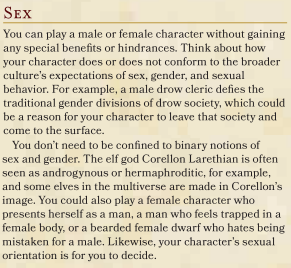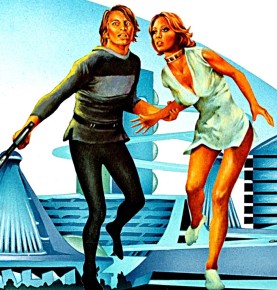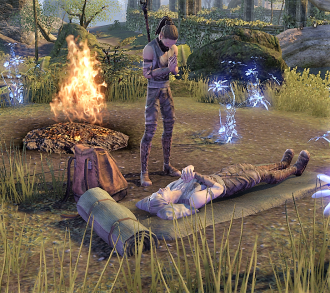Kotaku recently published an article on queerness in the D&D game. To be more specific, this article is about the inclusion of queer people and, more specifically, a glimpse into their lives as normal, accepted citizens of imaginary worlds. The fifth edition Player’s Handbook, for the first time in D&D history, makes a bold statement about sexuality and gender. It encourages you to imagine different. Several official D&D adventures depict queer couples or families. Many other games have similar modes of presentation, nodding toward normalcy. All these steps are positive. However, a few failures of imagination exist with regard to depicting this sort of equality in games and other media. (1)

So you don’t need to break out your PH.
Full transparency, I’m not queer. I am, however, strongly pro civil rights and inclusivity. But, when we were working on the fifth edition of the D&D game, I made a mistake regarding this issue. James Wyatt drafted that statement about sex and gender for the Player’s Handbook. I read it. I said to myself, maybe a little nervously, and giving in to internalized cultural pressure, “This goes without saying. D&D has always been about freedom to be who you want to be in the game.” I fired off an email to Jeremy Crawford, the D&D Managing Editor and Sage, to that effect. That email is proof that I had failed to imagine what the book’s clear statement would mean, and does mean, to queer folks marginalized in our society, even at our gaming tables.
That failing opened my eyes. I see my mistake from my current vantage. My open eyes also behold that I’m not alone in my failure of imagination. I see a lot of people saying this sort of talk politicizes gaming. Politics don’t belong. Gaming is an escape from the real world and its problems. (The irony that the desire to remove or ignore politics in gaming is a political statement is lost on some.)
Why do I call that position, harmless as it might seem, a failure of imagination? Let’s imagine from another angle.
Imagine a world in which same-sex sexuality and marriage are norms. Let’s say procreation is a controlled community procedure, in an “it takes a village” style. This world has several religions, but at least half of them have dictates on this marital structure. Where religion doesn’t influence this social order, cultural influences do. The marital structure is seen as traditional and stabilizing.
 Now imagine your very nature runs counter to this system. You want an opposite-sex partner. A significant percentage of your fellow citizens are like you. Despite science showing your relationship model hurts no one and creates strong familial bonds, traditionalists warn that accepting your “lifestyle choice” will inevitably lead to, summed up, the decline of civilization. A lot of people don’t want to confront you, but they also want to avoid your “issues,” especially in media and other leisure activities. Those aren’t the places for “politics.” But some of those on the traditional side see nothing wrong with making laws that restrict you, and rejecting you for jobs, housing, business opportunities, and so on. Radicals among these hardliners claim, without evidence, that you and those like you are mentally ill. They say you must be treated, “cured” by force if need be. A few see you as threat enough that violence is permissible if not called for. Fringe elements in your society even seek your death. In other places in this world, entire governments openly persecute and execute those like you. Exposure leads to tragic horror.
Now imagine your very nature runs counter to this system. You want an opposite-sex partner. A significant percentage of your fellow citizens are like you. Despite science showing your relationship model hurts no one and creates strong familial bonds, traditionalists warn that accepting your “lifestyle choice” will inevitably lead to, summed up, the decline of civilization. A lot of people don’t want to confront you, but they also want to avoid your “issues,” especially in media and other leisure activities. Those aren’t the places for “politics.” But some of those on the traditional side see nothing wrong with making laws that restrict you, and rejecting you for jobs, housing, business opportunities, and so on. Radicals among these hardliners claim, without evidence, that you and those like you are mentally ill. They say you must be treated, “cured” by force if need be. A few see you as threat enough that violence is permissible if not called for. Fringe elements in your society even seek your death. In other places in this world, entire governments openly persecute and execute those like you. Exposure leads to tragic horror.
Really imagine that. Feel it. For just a moment, feel it.
If you’re like me, you’re lucky. You and I need only imagine that scenario. Some people . . . many of my friends and loved ones, and maybe yours too . . . live something like that every day.
Presented a game world with that structure, many gamers among us would want to take up the mantle to fight the obvious oppression. Their imaginary heroes would push back. The theme of such a game might be focused on creating a more egalitarian, a more accepting, society.
That’s not what inclusivity in the D&D game today asks of us. All it’s asking of us is to accept. We’re asked to imagine that what we call queer from our real-world perspective is just normal in D&D worlds. Some people love people of their same biological sex. They marry. Maybe they raise kids. Nobody in the game world raises so much as an eyebrow.
The D&D game is helping us see this sort of love is normal and good. That’s a positive influence. It’s political, sure, because our society doesn’t accept these relationships as normal yet. Human rights are important. This position can’t avoid being political in our time. It shouldn’t. Hopefully, this influence allows players to examine their feelings and thoughts like I did.

The wood elf Hartmin with his dead husband.
But the D&D game’s presentation of the issue is far from radical. Acceptance is not built into modern versions of D&D worlds so much as presented, sidelong, as part of them. This failure is a world building issue and a legacy one. Many games with roots in decades less open than our own have this problem. Elder Scrolls games, for example, especially Elder Scrolls Online, present queer love in ways similar to the modern D&D game. A wood elf man asks you to bring his dying husband flowers from their youth, or a member of the same sex occupies one point on a love triangle. It’s progress, but it can feel appended. Because it is appended.
I can imagine far more sweeping statements in a game. A fictional world has none of the constraints of the real world. Queer love is presented the way it is in many modern games because the world building gaps aren’t filled. When a creator leaves such gaps, the assumptions of the audience rush in to fill the space. (2) Sometimes, creators themselves fill the fictional gaps with such preconceptions rather than conscious world building.
A lot of games or settings claim to be medieval fantasy. This design tactic allows a lot of shorthand because the audience can fill in missing elements with popular conceptions of medieval life. (3) So can the designers. Problems can arise when the designers leave out politics. That’s because popular conceptions of medieval life include all sorts of negative (and often mistaken) political stances, from sexism and racism and classism to religious oppression and homophobia and crusades. Too many games, and indeed other forms of fiction, leave gaps that are then poorly filled.
I can’t help but think of Witcher 3. The game has an amazing setting steeped in dark fairy-tale lore. This construction isn’t accidental. Some of Andrzej Sapkowski’s stories of Geralt of Rivia, the eponymous witcher, are fantastic retellings or extensions of stories such as Beauty and the Beast and Snow White. Sapkowski’s world is full of female characters with their own stories and important roles in that narrative. In fact, it could be argued that Sapkowski’s main saga is more about the women in it, their goals and roles, than Geralt.
The main story of Witcher 3 has that feel. Even though you play mostly as Geralt, women in his life have power and agency. They work with or against Geralt. And sometimes you play as Geralt’s adopted daughter, Ciri.

Mislav looks at Geralt, right after calling himself a freak.
Witcher 3, artistic triumph that it is, falls down mostly with the world around Geralt, including sidelong questionable statements about sex, race, and gayness, such as the plight and othering of Mislav early in the game. (4) It shows gaps where modern, popular pre- and misconceptions about northern European medieval life meet those of a world steeped in Abrahamic religious sensibilities. The issue is that none of that should apply to a carefully constructed fictional world supposedly rooted in an entirely different cosmology. Geralt’s world should have none of these influences, really. Indeed, it’s a fallacious claim that the Witcher’s world should resemble our medieval one in any way beyond the depictions in the original fiction. It’s not medieval Europe.
I can’t say for sure that none of this world design comes from Sapkowski’s books. I’ve read only three. But I can say that these notions didn’t appear in what I have read. Further, conscientious world building, a process wherein the fictional elements derive logically and thematically from one another in a progression, can be used to avoid these pitfalls. Since Geralt’s world isn’t our own, resemblances shouldn’t be assumptive or accidental.
From another angle, the D&D team often bemoaned receiving map roughs of temples showing row after row of pews in a great hall. Temple seating wasn’t common in medieval times or earlier. Designers can sometimes be forgiven, though, for filling in world building gaps with the familiar. Pews or their lack aren’t a big social issue. Mistreatment, exclusion, and demonization of fellow human beings, especially as background “color” in a game, are larger problems. The Witcher games and some D&D materials fall down on these hurdles. Again, conscientious design could have jumped them.
Some have argued that a fictional world has more resonance, seems more real, when it panders to popular expectations and myths. I don’t buy it. Fictional worlds have the most substance when they’re internally consistent. Logical structure, even when some of it is hidden to be revealed over time, is important. If anything, some of our most popular fictional settings, from D&D campaigns to Witcher 3 and Game of Thrones, fail at this time and again. Many of these failures thrive in the gaps.
Newer intellectual properties have the advantage in this vein. The Witcher started with a small studio making an ambitious game. Leaving gaps might have been necessary to get the work done. Future releases had to accept the flaws in the original or retcon existing elements. Most D&D worlds came up in another era with similar limitations expanding as more writing was accepted as canon. The gaps are still big. Fortunately for Wizards of the Coast and us, the gaps can be filled with the nods to equality we’re seeing in modern publications.
I, for one, would like to see more than nods. I’d like to see conscientious design with fewer gaps in everything from the important, such as social structure, to the academic, like geography. (5) Let’s see more worlds built without these gaps. (6) It’s not that hard to imagine.
(1) This discussion purposely leaves out the failures of courage that regularly occur in media when LGBTQ relationships and issues are depicted or examined. That’s important, but tangential to the point here.
(2) Familiarity and assumption can be used to fill a variety of gaps, from beliefs about sex and race to what a whale is. Problems arise when design relies on the gaps, sometimes while failing to be conscious of what they really are.
(3) Problem is that popular conceptions are often wrong, distasteful, or both.
(4) Some have hailed Mislav’s story as positive while also “authentic” to the era depicted. But my whole point here is the Witcher takes place neither on Earth nor during Earth’s history. Sure, Mislav’s story is more sympathetic than Witcher 2’s only gay character, who was a despicable villain. Mislav still protects people who’ve wronged him. Geralt has a chance to be nice to him, too. Mislav’s story also exists in a narrative space that’s common theme in the Witcher 3. That is, humans are the real monsters. However, the narrative and underlying world-building choice salient to this essay is that Mislav was ostracized, and a whole fiefdom fell into ruin, for no other reason than Mislav’s sexuality and the negative societal reaction to it. But why is his sexuality even an issue in this magical, polytheistic, and in many ways, sexually-liberal society?
(5) Mountains don’t have to match geographic standards in fantasy, but there has to be a reason why they don’t. Leave a gap, so to speak, and people will assume plate tectonics. It’s the same with any science. Like the widespread assumptions dragons and dragonborn are reptiles. (They’re not. Third edition filled that gap. Later editions solidified the fill.)
(6) I know about Blue Rose and Michtim. As examples of inclusive world building, they still have some gaps. Gaps are inevitable. It’s whether the gaps are intentional and meaningful that’s important. These gaps can be good. (True even if ugliness fills them, as long as that’s the narrative intent and it fits with the underlying world building.) I’ll talk about these settings later and link to that discussion here when I do.
Featured Image Credit: From the 7th Sea core rulebook, as found here.
Recent Comments